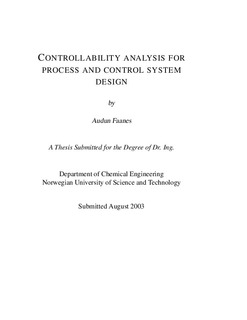| dc.contributor.author | Faanes, Audun | nb_NO |
| dc.date.accessioned | 2014-12-19T13:10:48Z | |
| dc.date.available | 2014-12-19T13:10:48Z | |
| dc.date.created | 2003-09-26 | nb_NO |
| dc.date.issued | 2003 | nb_NO |
| dc.identifier | 125046 | nb_NO |
| dc.identifier.isbn | 82-471-5629-6 | nb_NO |
| dc.identifier.uri | http://hdl.handle.net/11250/244486 | |
| dc.description.abstract | Controllability is the ability of a process to achieve acceptable performance, and in this thesis we use controllability analysis in the design of buffer tanks, feedforward controllers, and multivariable controllers such as model predictive control (MPC).
There is still an increasing pressure on the process industry, both from competitors (prize and quality) and the society (safety and pollution), and one important contribution is a smooth and stable production. Thus, it is important to dampen the effect of uncontrolled variations (disturbances) that the process may experience.
The process itself often dampens high-frequency disturbances, and feedback controllers are installed to handle the low-frequency part of the disturbances, including at steady state if integral action is applied. However, there may be an intermediate frequency range where neither of these two dampens the disturbances sufficiently. In the first part of this thesis we present methods for the design of buffer tanks based on this idea. Both mixing tanks for quality disturbances and surge tanks with “slow” level control for flow-rate variations are addressed.
Neutralization is usually performed in one or several mixing tanks, and we give recommendations for tank sizes and the number of tanks. With local PI or PID control, we recommend equal tanks, and give a simple formula for the total volume. We also give recommendations for design of buffer tanks for other types of processes. We propose first to determine the required transfer function to achieve the required performance, and thereafter to find a physical realization of this transfer function.
Alternatively, if measurements of the disturbances are available, one may apply feedforward control to handle the intermediate frequency range. Feedforward control is based mainly on a model, and we study the effect of model errors on the performance. We define feedforward sensitivities. For some model classes we provide rules for when the feedforward controller is effective, and we also design robust controllers such as μ -optimal feedforward controllers.
Multivariable controllers, such as model predictive control (MPC), may use both feedforward and feedback control, and the differences between these two also manifest themselves in a multivariable controller. We use the class of serial processes to gain insight into how a multivariable controller works. For one specific MPC we develop a state space formulation of the controller and its state estimator under the assumption that no constraints are active. Thus, for example the gains of each channel of the MPC (from measurements to the control inputs) can be found, which gives further insight into to the controller. Both a neutralization process example and an experiment are used to illustrate the ideas. | nb_NO |
| dc.language | eng | nb_NO |
| dc.publisher | Fakultet for naturvitenskap og teknologi | nb_NO |
| dc.relation.ispartofseries | Dr. ingeniøravhandling, 0809-103X; 2003:76 | nb_NO |
| dc.relation.haspart | Faanes, A.; Skogestad, S.. Buffer Tank Design for Acceptable Control Performance. Ind. Eng. Chem. Res. 42(10): 2198-2208, 2003. | nb_NO |
| dc.relation.haspart | Faanes, A.; Skogestad, S.. Offset free tracking with MPC under uncertainty: Experimental verification. . | nb_NO |
| dc.relation.haspart | Faanes, A.; Skogestad, S.. Control Structure Selection for Serial Processes with Application to pH-Neutralization. . | nb_NO |
| dc.subject | | en_GB |
| dc.subject | Kemiteknik | en_GB |
| dc.subject | TECHNOLOGY: Chemical engineering | en_GB |
| dc.title | Controllability analysis for process and control system design | nb_NO |
| dc.type | Doctoral thesis | nb_NO |
| dc.source.pagenumber | 204 | nb_NO |
| dc.contributor.department | Norges teknisk-naturvitenskapelige universitet, Fakultet for naturvitenskap og teknologi | nb_NO |
| dc.description.degree | dr.ing. | nb_NO |
| dc.description.degree | dr.ing. | en_GB |
